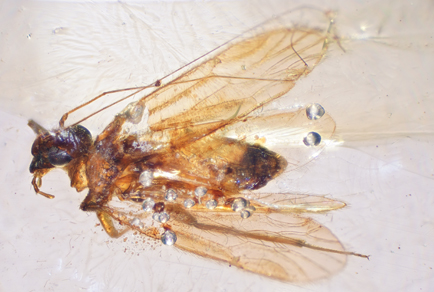Abstract
A new fossil psocodean species of the previously monospecific genus Paramanicapsocus is described from Burmese amber, namely Paramanicapsocus xingyuei sp. n.. This new species can be distinguished from the other species P. longiantennatus based on the hindwing vein M two-branched and the female gonapophyses with robust external valves.
References
- Azar, D., Hakim, M., Huang, D., Cai, C. & Nel, A. (2017) New fossil booklice from the Cretaceous amber of Myanmar (Psocodea: Troctomorpha: Amphientometae: Manicapsocidae). Cretaceous Research, 70, 8–14. https://doi.org/10.1016/ j.cretres.2016.09.013
- Baz, A. & Ortuno, V.M. (2001) A new electrentomoid psocid (Psocoptera) from the Cretaceous amber of Alava (Northern Spain). Deutsche Entomologische Zeitschrift, 48, 27–32. https://doi.org/10.1002/dez.200100004.
- Enderlein, G. (1911) Die Fossilen Copeognathen und ihre Phylogenie. Palaeontographica, 58, 279–360.
- Hakim, M., Azar, D. & Huang, D.Y. (2020) A unique manicapsocid (Psocodea: Amphientometae) from the mid-Cretaceous Burmese amber. Cretaceous Research, 107, 104278. https://doi.org/10.1016/j.cretres.2019.104278
- Liang, F.Y. & Liu, X.Y. (2021) A new species of Psyllipsocus (Psocodea: Trogiomorpha: Psyllipsocidae) from the mid-Cretaceous amber of Myanmar. Zootaxa, 5072 (1), 81–87. https://doi.org/10.11646/zootaxa.5072.1.9
- Lienhard, C. & Smithers, C.N. (2002) Psocoptera (Insecta): World Catalogue and Bibliography. Instrument Biodiversitatis V. Muséum d’histoire naturelle, Genève, 745 pp.
- Mao, Y.Y., Liang, K., Su, Y.T., Li, J.G., Rao, X., Zhang, H., Xia, F.Y., Fu, Y.Z., Cai, C.Y. & Huang, D.Y. (2018) Various amberground marine animals on Burmese amber with discussions on its age. Palaeoentomologyi, 1 (1), 91–103. https://doi.org/10.11646/palaeoentomology.1.1.11
- Mockford, E.L. (1967) The electrentomoid psocids (Psocoptera). Psyche, 74 (2), 118–165. https://doi.org/10.1155/1967/862560.
- Roesler, R. (1940) Neue und wenig bekannte Copeognathengattungen. I. Zoologischer Anzeiger, 129, 225–243.
- Shi, G., Grimaldi, D.A., Harlow, G.E., Wang, J., Wang, J., Wang, M., Lei, W., Li, Q. & Li, X. (2012) Age constraint on Burmese amber based on U-Pb dating of zicons. Cretaceous Research, 37, 155–163. https://doi.org/10.1016/j.cretres.2012.03.014
- Smith, R.D.A. & Ross, A.J. (2018) Amberground pholadid bivalve borings and inclusions in Burmese amber: implications for proximity of resin-producing forests to brackish waters, and the age of the amber. Earth and Environmental Science Transactions of the Royal Society of Edinburgh, 107 (2–3), 239–247. https://doi.org/10.1017/S1755691017000287mith & Ross 2018
- Smithers, C.N. (1966) Descriptions and new records of Atropetae, Psocatropetae and Amphientometae (Psocoptera) from Africa. Journal of the Entomological Society of Southern Africa, 28, 44–49.
- Smithers, C.N. (1972) The classification and phylogeny of the Psocoptera. Australian Museum Memoirs, 14, 1–349. https://doi.org/10.3853/j.0067-1967.14.1972.424
- Wang, R.Q., Li, S., Ren, D. & Yao, Y.Z. (2019) New genus and species of the Psyllipsocidae (Psocodea: Trogiomorpha) from mid-Cretaceous Burmese amber. Cretaceous Research, 104, 104178. https://doi.org/10.1016/j.cretres.2019.07.008
- Yoshizawa, K. (2005) Morphology of Psocomorpha (Psocodea: ‘Psocoptera’). Insecta Matsumurana, New Series, 62, 1–44.
- Yoshizawa, K. (2016) First description of the male of Manicapsocus (Psocodea: ‘Psocoptera’: Electrentomidae). Insecta Matsumurana, New Series, 72, 95–100.
- Zhang, Z.Q. (2011) Animal biodiversity: An outline of higher-level classification and survey of taxonomic richness. Zootaxa, 3148, 1–237.


